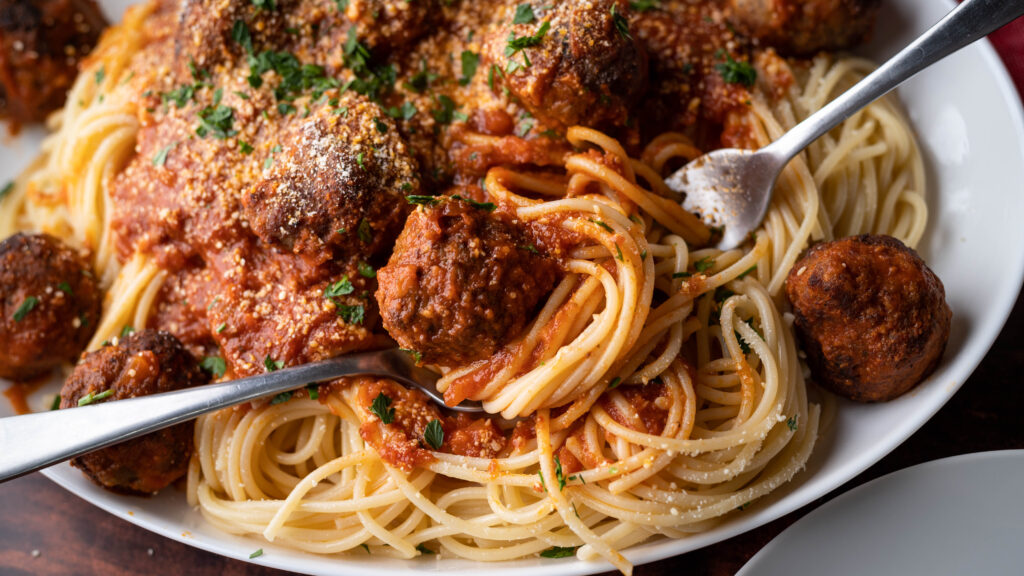Several years ago, while on a road trip, I ordered the now-discontinued spaghetti and meatballs during a pitstop at Denny’s. When the plate came out, I thought there was no way I could finish the massive platter, but then I did because it was right in front of me — even though I knew exactly what was going on.
As an assistant professor of health policy, I examine the food environment and how we can encourage healthier choices. What doesn’t help us make healthier choices are the outsized portion sizes being sold in restaurants. U.S. portions for packaged and fast foods have grown by up to five times since some of those items were first introduced, and the ubiquity of larger portions has taken off in the past 50 years.
advertisement
As my experience at Denny’s demonstrates, people eat and drink what’s set in front of them, even when it’s more than they intended or want. In one study, those who received portions that were 50% larger ate an average of 400 more calories in a day. That’s more than the calories found in two Krispy Kreme donuts. We know that more calories over time means weight gain. While excess weight gain is a complicated problem with myriad causes, reducing portion sizes is one harm reduction tool we have to address the problem.
My team and I conducted a study to show there is a simple, low-cost solution to this issue: Restaurants should start offering their entrées in two sizes. Fast food restaurants already give consumers size options; sit-down restaurants are starting to do the same. Places like Olive Garden offer lunch-sized versions of their classics, and the Cheesecake Factory offers “SkinnyLicious” options. But many people feel self-conscious ordering off a stigmatizing “SkinnyLicious” menu. There are other options: In one study, my team and I showed participants a menu that offered entrées in two sizes. We called the smaller option “standard” and the larger option “large.” For the control group, we did not label the smaller size. Those who saw the “standard” label were more likely to choose the smaller size.
Offering two sizes is a win for diners, public health, and even the restaurant industry. Americans now are eating out more than ever before, so for diners, ordering the smaller sized entrée means being shielded from the temptation to consistently overeat. If enough individuals eat fewer calories and less saturated fat and sodium, that will have public health benefits. In turn, the restaurant industry can capitalize on a technique currently used by big beverage and snack brands. That is, rather than getting more people to buy a soda, they offer more sizes of that soda to accommodate various occasions and types of consumers. This tactic has led to increased revenue for The Coca-Cola Company, for example, which introduced the 7.5-oz mini can nationally in 2010.
advertisement
As a public health researcher, I’d rather people not drink sugary beverages altogether. But that isn’t realistic. This technique makes moderation easier. A 7.5-oz can of soda usually means drinking 7.5-oz of soda. Similarly, receiving a 695-calorie Cajun Shrimp & Chicken Pasta at TGI Fridays would mean eating, at most, 695 calories, instead of the current 1,390.
Our norms toward large portions developed gradually over time. It will take time to bring us back to a level in which a 1,000-calorie entrée would be met with the shock it should get.
One challenge is that consumers see sizing up as a way to save money: Why buy the 230-calorie fries for $4 when you can pay just $2 more to get double that amount? But the menu boards don’t convey the costs of excess weight gain. There are the physical costs, which includes increased risk for heart disease and type 2 diabetes. There are the financial costs: Excess weight doubles personal health care costs annually and, at a societal level, contributes over $260 billion in health care costs. There are also the personal costs: the difficulty of losing weight once gained, and the effects on mental health. In our study and in others, however, we found that when a reduced size is offered, people choose it even if it costs slightly more per ounce of food.
What’s great about focusing on portion sizes is that it’s not about abstinence but about harm reduction. You don’t have to skip the fettuccine alfredo or the spicy jambalaya entirely. If restaurants offer those 1,000+ calorie items in a smaller size, diners can still eat what they want without sacrificing their health. In doing so, restaurants may encounter a welcome paradox: By giving their customers options to eat less, more people may show up to the table.
Sophia Hua is an assistant professor of health policy at the University of Pennsylvania. For more than a decade, she has researched ways we can change the food environment to make the healthier choice the easier choice.
advertisement

